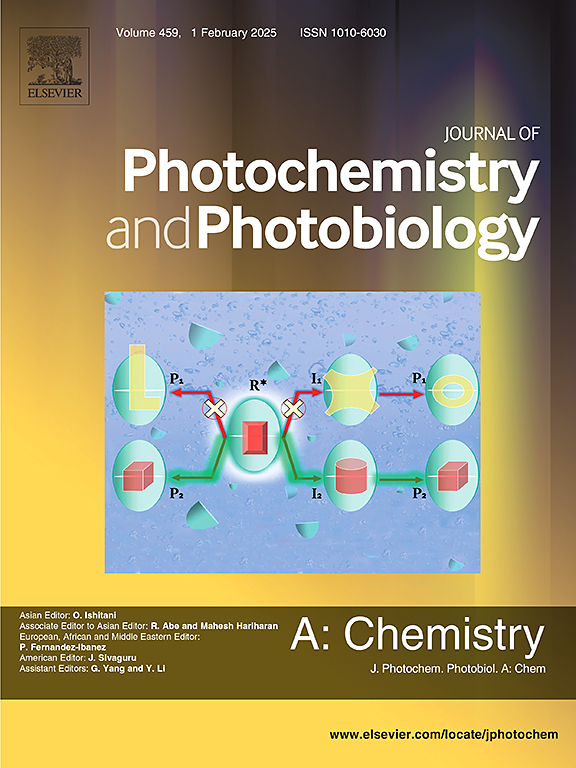Hetero-metal MOF derivatives anchored on porous carbonized wood as photo-Fenton catalysts for ultrafast organic pollutant removal
IF 4.1
3区 化学
Q2 CHEMISTRY, PHYSICAL
Journal of Photochemistry and Photobiology A-chemistry
Pub Date : 2025-07-12
DOI:10.1016/j.jphotochem.2025.116616
引用次数: 0
Abstract
Hetero-metal organic framework (HMOF) derivatives have emerged as promising photo-Fenton catalysts for removing hazardous organic pollutants from wastewater. However, most proposed catalysts suffer from low photocatalytic activity due to self-aggregation, structural instability, and limited active sites, which hinder their industrial feasibility. Herein, we report a highly efficient Cu–Fe/WPC catalyst (WPC denotes wood-converted porous carbon) featuring HMOF-derived Cu-Fe bimetallic nanoparticles embedded in the WPC skeleton. Under optimal conditions, the Cu-Fe/WPC/H2O2/UV system exhibits exceptional degradation performance for methylene blue (MB) and sulfamethoxazole (SMX), with rapid pseudo-first-order rate constants of 1.397 and 1.489 min−1, respectively. Notably, this hybrid photocatalyst achieves complete degradation of MB and SMX within 5 min. The synergistic catalysis between Fe and Cu dual active sites plays a crucial role in enhancing photo-Fenton activity. This synergy boosts the electron-transfer capacity during the valence-state evolution of copper and accelerates the Fe (III)/Fe (II) redox cycle in the Fenton reaction. Additionally, the conversion of Fe species in the Cu-Fe/WPC/H2O2 system dominates H2O2 activation, generating abundant hydroxyl radicals (·OH) that subsequently participate in the degradation of organic pollutants. This study presents innovative strategies for synthesizing wood-based porous carbon-supported HMOF derivative catalysts designed for ultra-fast photo-Fenton degradation of emerging organic pollutants.

锚定在多孔炭化木材上的杂金属MOF衍生物作为光fenton催化剂超快速去除有机污染物
杂金属有机骨架(HMOF)衍生物已成为去除废水中有害有机污染物的光fenton催化剂。然而,由于自聚集、结构不稳定和活性位点有限,大多数催化剂的光催化活性较低,阻碍了它们的工业可行性。在此,我们报道了一种高效的Cu-Fe /WPC催化剂(WPC表示木材转化的多孔碳),其特征是hmof衍生的Cu-Fe双金属纳米颗粒嵌入WPC骨架中。在最佳条件下,Cu-Fe/WPC/H2O2/UV体系对亚甲基蓝(MB)和磺胺甲恶唑(SMX)表现出优异的降解性能,快速伪一阶速率常数分别为1.397和1.489 min−1。值得注意的是,该杂化光催化剂在5分钟内实现了对MB和SMX的完全降解。Fe和Cu双活性位点之间的协同催化对提高光芬顿活性起着至关重要的作用。这种协同作用增强了铜价态演化过程中的电子转移能力,加速了Fenton反应中Fe (III)/Fe (II)的氧化还原循环。此外,Cu-Fe/WPC/H2O2体系中Fe的转化主导H2O2的活化,产生丰富的羟基自由基(·OH),参与有机污染物的降解。本研究提出了合成木质多孔碳负载的HMOF衍生物催化剂的创新策略,该催化剂设计用于超快速光- fenton降解新兴有机污染物。
本文章由计算机程序翻译,如有差异,请以英文原文为准。
求助全文
约1分钟内获得全文
求助全文
来源期刊
CiteScore
7.90
自引率
7.00%
发文量
580
审稿时长
48 days
期刊介绍:
JPPA publishes the results of fundamental studies on all aspects of chemical phenomena induced by interactions between light and molecules/matter of all kinds.
All systems capable of being described at the molecular or integrated multimolecular level are appropriate for the journal. This includes all molecular chemical species as well as biomolecular, supramolecular, polymer and other macromolecular systems, as well as solid state photochemistry. In addition, the journal publishes studies of semiconductor and other photoactive organic and inorganic materials, photocatalysis (organic, inorganic, supramolecular and superconductor).
The scope includes condensed and gas phase photochemistry, as well as synchrotron radiation chemistry. A broad range of processes and techniques in photochemistry are covered such as light induced energy, electron and proton transfer; nonlinear photochemical behavior; mechanistic investigation of photochemical reactions and identification of the products of photochemical reactions; quantum yield determinations and measurements of rate constants for primary and secondary photochemical processes; steady-state and time-resolved emission, ultrafast spectroscopic methods, single molecule spectroscopy, time resolved X-ray diffraction, luminescence microscopy, and scattering spectroscopy applied to photochemistry. Papers in emerging and applied areas such as luminescent sensors, electroluminescence, solar energy conversion, atmospheric photochemistry, environmental remediation, and related photocatalytic chemistry are also welcome.

 求助内容:
求助内容: 应助结果提醒方式:
应助结果提醒方式:


